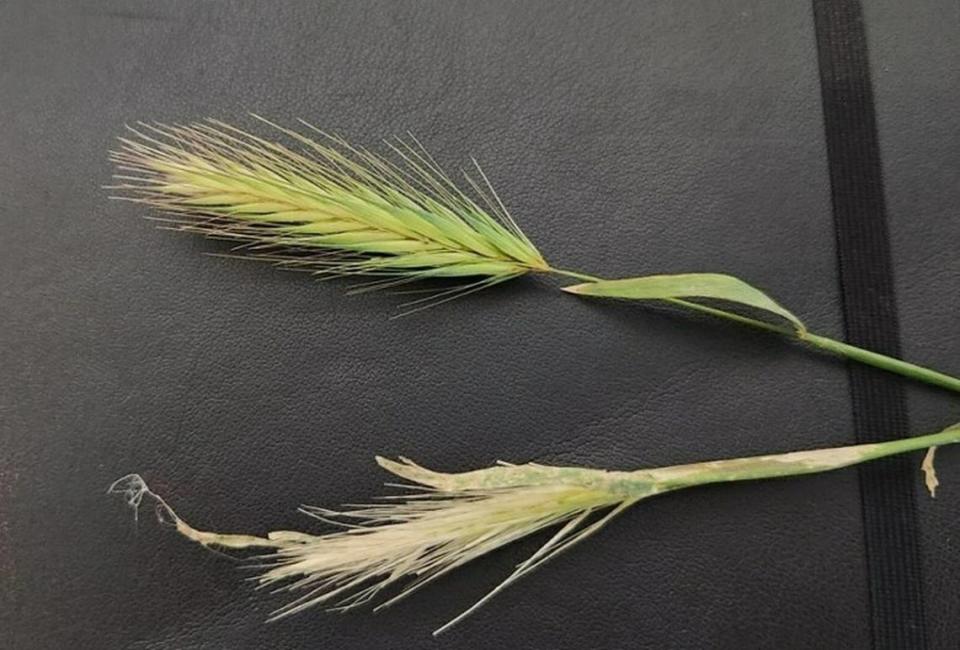‘Evil little things’: This California plant could hurt your pet and cost you thousands
The extreme amount of rainfall that drenched California for months bloomed plants capable of causing severe health complications — or even death — for your dog.
Once your pet walks by a foxtail and the fine, hairy seed heads attach to their fur, the clock starts ticking.
The invasive weed resembles the tail of a fox, hence the name, and comes in a variety of species.
The long v-shaped appendage is decorated with dozens of spiky clusters of seeds with backward-facing barbs. The seed heads can be tiny or stretch between 2 and 3 inches long.
Foxtail injury is “exceptionally common” across the Sacramento region, said general practitioner Dr. Erik Olstad, an assistant clinical professor with the UC Davis William R. Pritchard Veterinary Medical Teaching Hospital. During foxtail season, between spring and summer, general practitioners in emergency room settings manage multiple cases per day and an influx of cases on weekends.
“It’s a really hard battle and this is such a big deal in California veterinary practice,“ Olstad said.
To learn how the grass-like weed can harm your pet, The Bee consulted three local animal health experts.. Here’s what we found:
Why are foxtails dangerous to pets?
If you look hard enough on the next walk with your dog, you will probably see a foxtail.
The ubiquitous annual plant can grow in both moist and dry conditions, making them adaptable to a range of environments like gardens, fields, roadsides, sidewalk cracks and crops, according to UC Integrated Pest Management.
Jamie Larson, a director of animal services with the Sacramento Society for the Prevention of Cruelty to Animals, said the fluffy plant looks “really pretty” and accentuates a lawn until they dry out.
The green awns will eventually harden and become needle-like once the weather warms.
The grasses will then splinter into hundreds of tiny little arrows and patiently waits for your pet.
The seed takes little to no time to burrow inside your dog, entering through their paw, nose, ears, eyes or skin. The same goes for any furry friend — cats, rabbits or ferrets — any pet that spends time outdoors.

Once the foxtail seed penetrates your animal’s body with its sharp ends, the microscopic barbs guide it on a one-way journey to almost anywhere.
If you don’t catch it early, your pet’s tissue or organs can be pierced and the bacteria-infested seed can cause a problem only a vet can help cure.
The result: infection, inflammation and severe pain.
“Foxtails are evil little things...we can find them in every nook and cranny and orifice of an animal,” said Larson, a registered veterinarian technician.
Chambers of the heart. Cranial vault inside the skull. The lungs.
“We’re talking thousands upon thousands of dollars and not a perfect prognosis for that,” Olstad said.
Is a foxtail stuck inside my pet?
The signs of foxtail injury in pets resemble common diseases like ear infections and allergies, which could make at-home assessments difficult.
If your animal shows the following symptoms, immediately take them to the vet:
Squinting or tearing of the eye
Eye discharge
Excessive chewing along their body
Ear pain
Pawing at the ear
Head or ear shaking
Swollen paws, eyes or legs
Paw licking
Constant sneezing with or without bloody discharge
Bleeding or discharge from the genitals
Excessive licking of the genitals
Tiny hole with puss coming out of it
Treatment at the hospital will depend on the location of the seed, said Dr. Rebecca Price with Sacramento County Bradshaw Animal Shelter, who performs surgeries and exams for shelter and foster animals.
In an email to The Bee, Price said pets will typically need to be sedated or put under general anesthesia to allow the vet to search for and remove the seed.
In more challenging cases, the pet will need surgery so vets can make an incision and pull the seed out.
“There’s never just one,” Olstad said.
“I’m not looking forward to this year’s foxtail season.”
After the seed is removed, the animal may need antibiotics as well as anti-inflammatory and pain management medications.
Foxtail prevention for pets
In rare cases, a foxtail left unchecked could be fatal.
Generally, your pet walks away with an infection and you walk away with a vet bill.
“Unfortunately our dogs can’t live in a bubble,” Larson said. “So everything we do, just as people, there’s always a little bit of risk.”
Olstad’s advice: Check your pet’s paws, armpits and crotch region after walks.
Price added ears, eyes, mouth, nose and coat to the list as well as:
Avoid areas like yards and fields where foxtails are present Perform regular weed and garden maintenance around your property Keep the fur on the paws and along the body trimmed to decrease foxtail trappings
If your dog is fluffy, groom and check their skin regularly.
Masks and booties are “wonderful,” especially for those living in the foothills. Foxtail-specific masks are made out of material similar to a mosquito net and cover the animal’s eyes, ears and nose.
What do you want to know about life in Sacramento? Ask our service journalism team your top-of-mind questions in the module below or email servicejournalists@sacbee.com.

